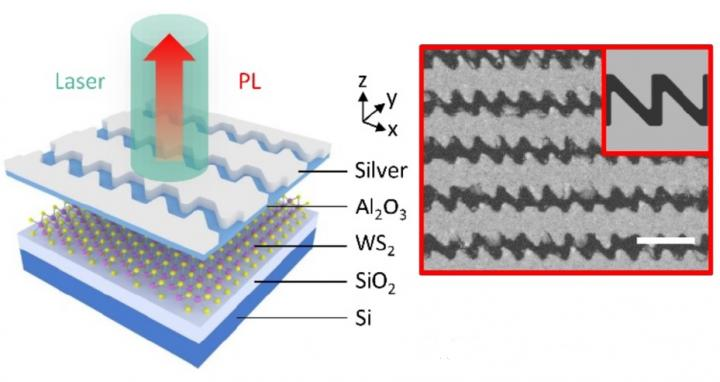Feb 10 2020
Researchers from the University of Groningen have generated valley-coherent photoluminescence in two-dimensional (2D) tungsten disulfide flakes at ambient temperature. They achieved this by using a silver sawtooth nanoslit array.
 After excitation of the device with green laser light (green), coherent fluorescence occurs (red) thanks to the silver saw tooth (right panel). The scale bar is 500 nm. Image Credit: Han and Ye, University of Groningen.
After excitation of the device with green laser light (green), coherent fluorescence occurs (red) thanks to the silver saw tooth (right panel). The scale bar is 500 nm. Image Credit: Han and Ye, University of Groningen.
To date, such photoluminescence could be realized only at extremely low temperatures. In quantum electronics, it is possible to use coherent light to transfer or store information. This plasmon-exciton hybrid device holds the potential for use in integrated nanophotonics (electronics based on light). The study outcomes were described in Nature Communications on February 5th, 2020.
Tungsten disulfide is available as a 2D material and exhibits fascinating electronic properties.
The electronic structure of monolayer tungsten disulfide shows two sets of lowest energy points or valleys.
Justin Ye, Associate Professor and Head of the Device Physics of Complex Materials group, University of Groningen
One viable application is in the area of photonics, as it has the ability to emit light with valley-dependent circular polarization—a new degree of freedom to manage information. But coherent and polarized light is needed for valleytronics. Sadly, earlier studies revealed that photoluminescence polarization in tungsten disulfide is virtually random at ambient temperature.
Valleys
According to Ye, “Tungsten disulfide is unique in that these two valleys are not identical.” This implies that generating linearly polarized light requires both valleys to respond coherently to produce light in the photoluminescence.
But the intervalley scattering at room temperature largely destroys the coherence, so appreciable coherence is only achieved at very low temperatures that are close to zero.
Justin Ye, Associate Professor and Head of the Device Physics of Complex Materials group, University of Groningen
Together with Chunrui Han, his postdoctoral researcher (working now at the Institute of Microelectronics, Chinese Academy of Sciences), Ye thus attempted to use a different technique to produce linearly polarized light by making use of a plasmonic metasurface, which is in the form of a silver sawtooth nanoslit array.
This material interacts vigorously with tungsten disulfide and exhibits the ability to transfer resonance triggered by light as an electromagnetic field in the metal. “It enhances the light-material interaction,” stated Ye.
Silver
At room temperature, the linear polarization brought about by the valley coherence is increased to nearly 27% by depositing a thin silver metasurface layer on top of a tungsten disulfide monolayer.
This room temperature performance is even better than the valley polarization obtained in many previous reports measured at very low temperatures.
Justin Ye, Associate Professor and Head of the Device Physics of Complex Materials group, University of Groningen
It is possible to further increase the linear polarization up to 80% by combining the plasmonic resonance anisotropy, in the form of the sawtooth pattern, with the tungsten disulfide’s optical response. This implies that Ye and Han can now trigger linearly polarized photoluminescence in this material.
This achievement will enable the use of both plasmonic coherence of metasurfaces and tungsten disulfide’s valley coherence in optoelectronics at room temperatures. The next step is to use electrical input as an alternative for the laser light that induced photoluminescence.